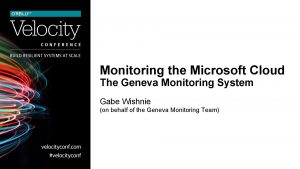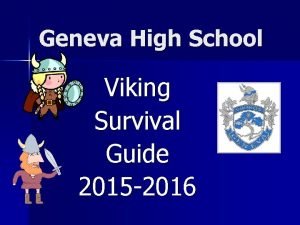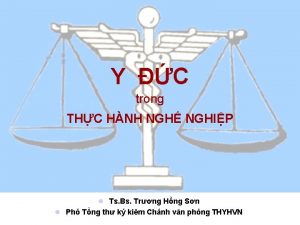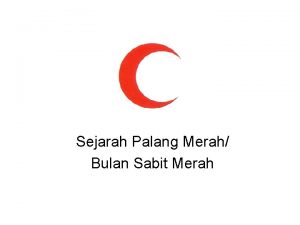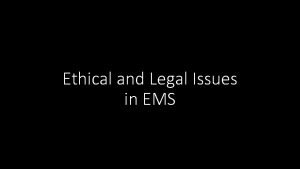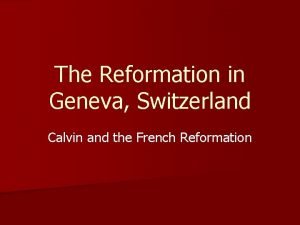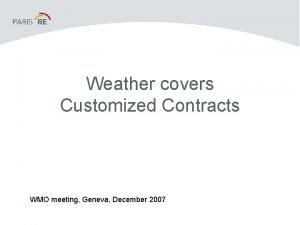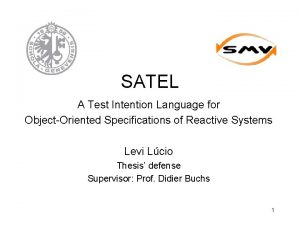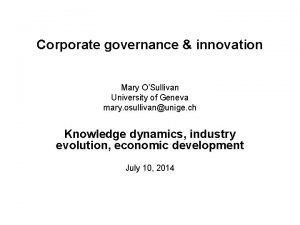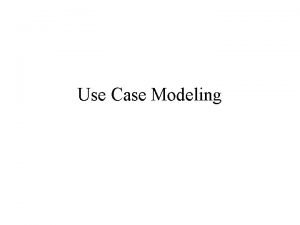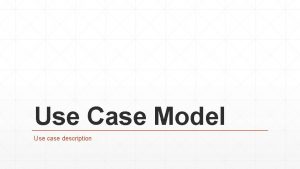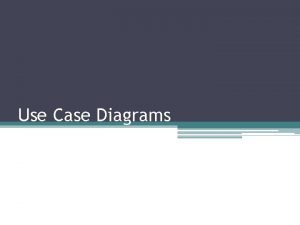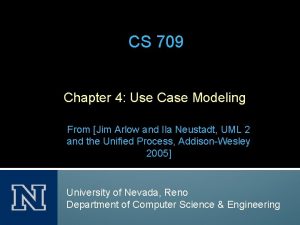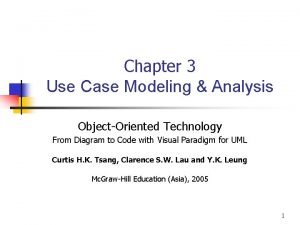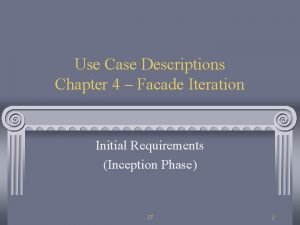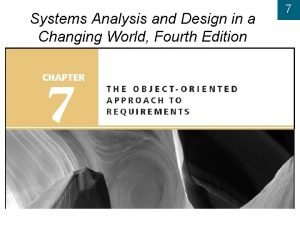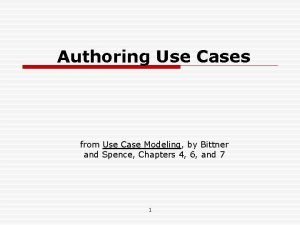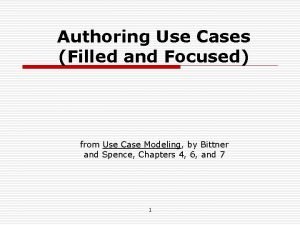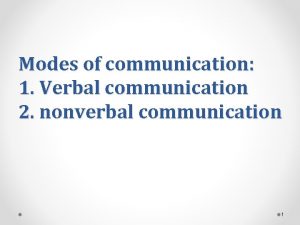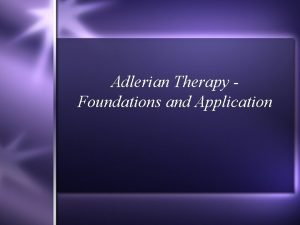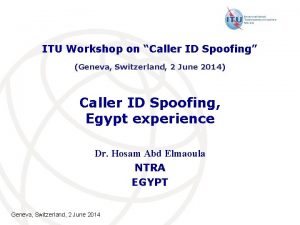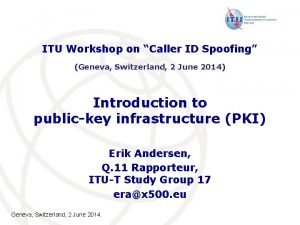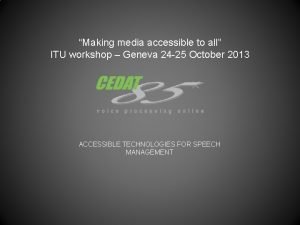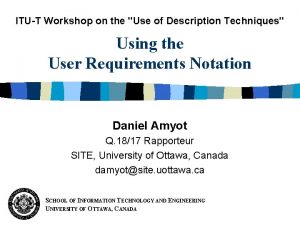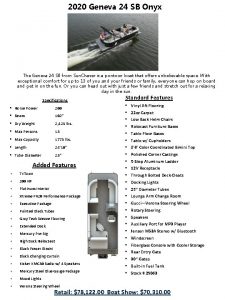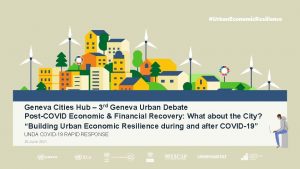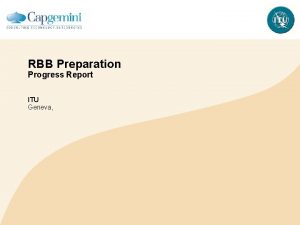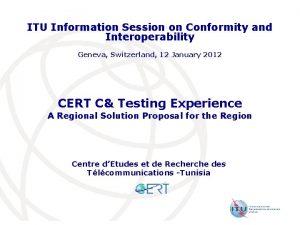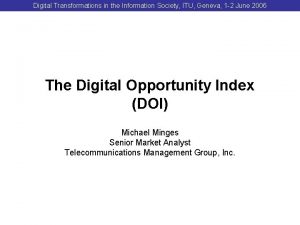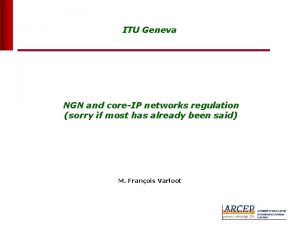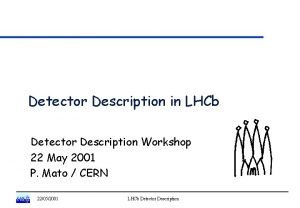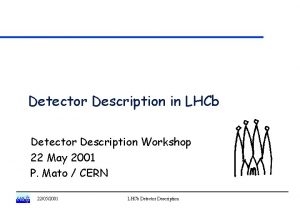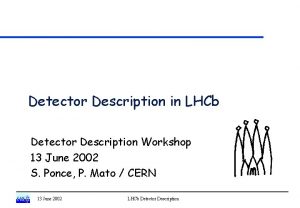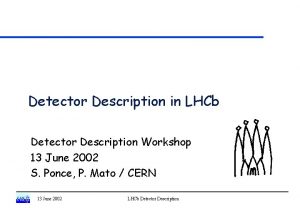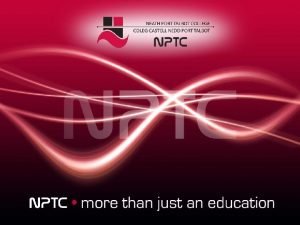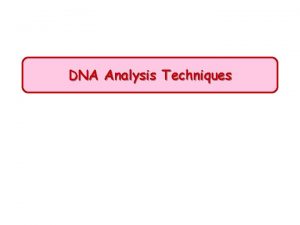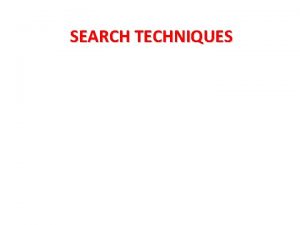ITU Workshop Use of Description Techniques Geneva 23



























- Slides: 27

ITU Workshop "Use of Description Techniques" Geneva, 23. Nov. 2002 The Use of OO-Modelling Principles (OOM) and UML Notation to Define Signalling Requirements Raphael J. Schumacher, Rapporteur Q. 8/11 Swisscom AG, Switzerland ITU Workshop on "Use of Description Techniques"

“Use of OOM and UML to define Signalling Requirements” A little story about a personal experience in. . . attempting to motivate the use of object-oriented modelling techniques in SG 11. . . advocating the advantages for the experts’ work. . . the attention achieved in the process. . . observations and conclusions ITU Workshop on "Use of Description Techniques" 03/12/2020 2

“Use of OOM and UML to define Signalling Requirements” Contents 1 Introduction – Preamble – About Signalling Requirements – The OOM Story in SG 11 2 Why OO-Modelling & UML – OO-Analysis & -Design (OOA/D) – OO-Modelling (OOM) – Telecom vs. Computing Intro OOM 3 OOM for BICC Requirements – Purpose and Benefits – Existing BICC CS 2 Signalling Requirements – Supplementing BICC Signalling Requirements 4 Results & Conclusion – Reception by the meetings – Personal observations – Long-term view BICC Results ITU Workshop on "Use of Description Techniques" 03/12/2020 3

“Use of OOM and UML to define Signalling Requirements” 1 Introduction – Preamble – About Signalling Requirements – The OOM Story in SG 11 2 Why OO-Modelling & UML – OO-Analysis & -Design (OOA/D) – OO-Modelling (OOM) – Telecom vs. Computing Intro OOM 3 OOM for BICC Requirements – Purpose and Benefits – Existing BICC CS 2 Signalling Requirements – Supplementing BICC Signalling Requirements 4 Results & Conclusion – Reception by the meetings – Personal observations – Long-term view BICC Results ITU Workshop on "Use of Description Techniques" 03/12/2020 4

“Use of OOM and UML to define Signalling Requirements” SG 11 Signalling Requirements - what’s this? § Question to be answered before protocol development starts: “What do we expect the particular signalling protocol to do? ” § A collection of functional requirements on a signalling protocol that is destined for specific purposes and applications: – That is, signalling requirements need to identify. . . – The context of usage (= equal to an applicability statement? ) – All the scenarios that need to be applicable – Hence signalling requirements would contain Intro OOM BICC Results – Signalling [network] architecture and functional elements – Description of network functions that are needed – Functional elements to be implemented ( != physical elements) Ideally. . . ITU Workshop on "Use of Description Techniques" 03/12/2020 5

“Use of OOM and UML to define Signalling Requirements” The Proposal for SG 11 BICC Capability Set 3 (Bearer Independent Call Control) Intro – BICC is a framework for providing ISDN services over transport technologies beyond simply TDM: ATM AAL 1, AAL 2, IP, MPLS. – In the light of the starting BICC CS 3 activity, further ways to improve the modelling techniques for envisaged signalling architecture were seeked. – This resulted in a contribution brought into WP 2/11 at the SG 11 meeting in Mai 2001: Delayed Contribution D. 229 – 2/11 Aim: to propagate the idea of using OOM and UML for the development of signalling requirements OOM BICC Results ITU Workshop on "Use of Description Techniques" 03/12/2020 6

“Use of OOM and UML to define Signalling Requirements” 1 Introduction – Preamble – Story line – About myself and SG 11 2 Why OO-Modelling & UML – OO-Analysis & -Design (OOA/D) – OO-Modelling (OOM) – Telecom vs. Computing Intro OOM 3 OOM for BICC Requirements – Purpose and Benefits – Existing BICC CS 2 Signalling Requirements – Supplementing BICC Signalling Requirements 4 Results & Conclusion – Reception by the meetings – Personal observations – Long-term view BICC Results ITU Workshop on "Use of Description Techniques" 03/12/2020 7

“Use of OOM and UML to define Signalling Requirements” Object-Oriented Analysis & Design (OOA/D) § A very, very little history: – late 1980 s: OO programming languages (Smalltalk, C++) – early 1990 s: OOA/D techniques (Booch, Rumbaugh, Jacobson, . . . ) – late 1990 s: joint effort to develop the UML standard; adopted by OMG § OOA&D as conceptual tool was originally directly associated with software development: – OOA: Analysing a system and its environment, as well as the requirements on the system, seen from a user’s perspective – OOD: Intro OOM BICC Results Documentation on the concept, and the design of the implementation (== the inside of the system) – UML: UML as notation standard; UML tools with the purpose to automatically create program code out of the object-oriented models. ITU Workshop on "Use of Description Techniques" 03/12/2020 8

“Use of OOM and UML to define Signalling Requirements” Object-Oriented Modelling (OOM) § Simply going beyond the purpose of developing software : – OOA, OOD & UML are description techniques, thus probably also applicable for other things than software development. – Meanwhile, modelling is used in many areas, e. g. : Intro OOM BICC Results – Business engineering: modelling of enterprises in terms of purpose, processes and organisational entities – Service development: service components and their associations amongst themselves as well to network capabilities – Database design & data warehouses: data structures, specifications for data mining and information exchange (XML/DTD) – Telecom Operations Map (TOM): a framework for a process architecture suitable to telecommunications service providers – Network Management Systems: managed objects (MIBs) Why not make profit from OOM & UML in ITU efforts as well? ITU Workshop on "Use of Description Techniques" 03/12/2020 9

“Use of OOM and UML to define Signalling Requirements” Telecommunication vs. Computing § Telecommunication & computing industry is converging – How will the demarcation line look like in - let’s say - 5 years? A grey area by best. . . – Who will be faced to communication standards in future? – SW developers incorporating telecom modules into vertical products – Integrators struggling with service convergence telecommunication services won’t remain stand-alone products – As a consequence, the dominant customers of ITU standards will more and more be. . . Intro OOM BICC Results – software engineers for whom OOM has become everyday practise – service providers which need to cope with the increased complexity ITU Workshop on "Use of Description Techniques" 03/12/2020 § Telecom services convergence, a long-term business need 10

“Use of OOM and UML to define Signalling Requirements” 1 Introduction – Preamble – Story line – About myself and SG 11 2 Why OO-Modelling & UML – OO-Analysis & -Design (OOA/D) – OO-Modelling (OOM) – Telecom vs. Computing Intro OOM 3 OOM for BICC Requirements – Purpose and Benefits – Existing BICC CS 2 Signalling Requirements – Supplementing BICC Signalling Requirements 4 Results & Conclusion – Reception by the meetings – Personal observations – Long-term view BICC Results ITU Workshop on "Use of Description Techniques" 03/12/2020 11

“Use of OOM and UML to define Signalling Requirements” OOM @ BICC: Purpose and Benefits OOM can be used to: Benefits: § define processes and information flows § further refine the scope of BICC capabilities and their protocols § identify relationships between processes and information § improve the common understanding of terminology § increase the degree of reuse (protocol) requirements and components § improved documentation of BICC and its evolution (CS 1. . CS 3) § improve quality control and consistency check on protocol designs Intro OOM BICC Results ITU Workshop on "Use of Description Techniques" 03/12/2020 § trace protocol standardisation (from req’s to test specifications) 12

“Use of OOM and UML to define Signalling Requirements” Existing BICC CS 2 Signalling Requirements Signalling Transport Network TE Other service supplier networks Call Control Signalling Bearer Control Signalling Call & Bear Control (CBC) Signalling TE Access Control Signalling Access Network TSN-x ISN-A CSF-N TE BCF-N (v) Bearer Inter-working Function (BIWF) GSN-x CSF-T SWN-1 BCF-R BCF-T (w) Backbone Network Connection Link Intro CSF-G SWN-2 BCF-R BCF-G (x) CMN-x GSN-y CSF-C CSF-G BCF-G (y) BCF-J SWN-3 BCF-R ISN-B ACNE CSF-R CSF-N BCF-N (z) ACN-w BCF-R BCF-A (a) TE Joint Domain Bearer Inter-working Function (BIWF) Backbone Network Connections Network Bearer Connection (end to end) OOM Scope of Signalling Requirements BICC Results ITU Workshop on "Use of Description Techniques" 03/12/2020 13

“Use of OOM and UML to define Signalling Requirements” Supplementing BICC Signalling Requirements Overall 1/6 Requirements Intro OOM Use Cases -> helps to refine scope BICC Results ITU Workshop on "Use of Description Techniques" 03/12/2020 14

“Use of OOM and UML to define Signalling Requirements” Supplementing BICC Signalling Requirements 2/6 Flows Information Intro OOM Use Case -> overview of scenarios BICC Results ITU Workshop on "Use of Description Techniques" 03/12/2020 15

“Use of OOM and UML to define Signalling Requirements” Supplementing BICC Signalling Requirements 3/6 Model Information Intro OOM Class diagrams -> improve understanding the principle idea of BICC Results ITU Workshop on "Use of Description Techniques" 03/12/2020 16

“Use of OOM and UML to define Signalling Requirements” Supplementing BICC Signalling Requirements 4/6 Information Model further refined class Intro diagrams OOM BICC Results ITU Workshop on "Use of Description Techniques" 03/12/2020 17

“Use of OOM and UML to define Signalling Requirements” Supplementing BICC Signalling Requirements 5/6 Zooming into individual BICC components “Play it again Sam!”, and: Intro OOM BICC Results ITU Workshop on "Use of Description Techniques" 03/12/2020 18

“Use of OOM and UML to define Signalling Requirements” Supplementing BICC Signalling Requirements 5/6 be much more to be modelled! And there’d Intro OOM BICC Results ITU Workshop on "Use of Description Techniques" 03/12/2020 19

“Use of OOM and UML to define Signalling Requirements” 1 Introduction – Preamble – Story line – About myself and SG 11 2 Why OO-Modelling & UML – OO-Analysis & -Design (OOA/D) – OO-Modelling (OOM) – Telecom vs. Computing Intro OOM 3 OOM for BICC Requirements – Purpose and Benefits – Existing BICC CS 2 Signalling Requirements – Supplementing BICC Signalling Requirements 4 Results & Conclusion – Reception by the meetings – Personal observations – Long-term view BICC Results ITU Workshop on "Use of Description Techniques" 03/12/2020 20

“Use of OOM and UML to define Signalling Requirements” Reception by the Meeting (of WP 2/11) Achieved Interest § Remarkable interest shown by SG 11 management § Moderate interest seen from participants progressing work § Gap between S. P. and Suppliers Statement of Scepticism § Nice, but do we really need this? Intro OOM BICC Results § Learning curve steep enough? § Return on investment? ITU Workshop on "Use of Description Techniques" 03/12/2020 Possible Reasons for Spectisism (Past) Experiences with Notations § SDL: Widely adopted within SG 11 (protocol standards, typically specifying the state machines), but applied in the right way? § TTCN: ratio of sophistication vs. value was not perceived to be very promising to individuals § Little popularity of concept work “With IP, everything is easier” 21

“Use of OOM and UML to define Signalling Requirements” Personal Observations “Contemporary” factors “Hidden” factors § Time pressure § Conceptual work -> get out standards fast § Little resources available -> reduce efforts to the minimum § Increased Fluctuation -> people change, know-how changes. . . § Current quality control system Intro OOM -> iterative approach: changes to standards as implementers discover imperfect parts BICC Results ITU Workshop on "Use of Description Techniques" 03/12/2020 – generally having a hard time – benefits not convincing enough § ITU “hidden law”: A playground for different parties with particular interests. Lobbying e. g. to. . . – advocate a specific solution – slow down progress of work? -> often, full transparency is not necessarily desired -> poisons top down approaches 22

“Use of OOM and UML to define Signalling Requirements” Personal Long-term Views Think positive! Summing up § Complexity in telecom will continue to increase § Need for conceptual work -> a common understanding of technical and conceptual issues is indispensable § Parties with particular interest in transparency: Intro OOM BICC Results – Governments: regulation, lawful interception – Service Providers: service convergence challenge, cope with network complexity ITU Workshop on "Use of Description Techniques" 03/12/2020 – still an indisputable necessity – adoption of new techniques takes a lot of time -> patience with optimism § Factors for success/failure: – on actual participation (parties) – market pressures (competition) – the mood of telecom business Better days will be coming again 23

“Use of OOM and UML to define Signalling Requirements” Thank you!. . . and enjoy your stay in Switzerland . . . despite the *? +!%ç&*/ weather! coffee break now? psst! ITU Workshop on "Use of Description Techniques" 03/12/2020 24

“Use of OOM and UML to define Signalling Requirements” Supplemental BACKUP ITU Workshop on "Use of Description Techniques" 03/12/2020 25

“Use of OOM and UML to define Signalling Requirements” Links & Book References 1/2 OOA/D § http: //www. sdmagazine. com/articles/1999/0006 a/0006 a. htm § “Building Object Applications That Work: Your Step-By-Step Handbook for Developing Robust Systems with Object Technology” by Scott W. Ambler (Cambridge University Press, 1998) OOM Intro OOM § http: //www. ambysoft. com/e. Commerce. Architecture. html § http: //www. sdmagazine. com/articles/1999/0004 o/0004 o. htm § “Business Engineering With Object Technology” by David Taylor (John Wiley and Sons, 1995) § “Enterprise Modelling with UML” by Chris Marshall (Addison-Wesley, Object Technology series, 1999) BICC Results ITU Workshop on "Use of Description Techniques" 03/12/2020 26

“Use of OOM and UML to define Signalling Requirements” Links & Book References 2/2 UML § http: //www. omg. org/uml § http: //www. rational. com/uml § “The Unified Modeling Language Reference Manual” by Grady Booch, James Rumbaugh, and Ivar Jacobson (Addison-Wesley, Object Technology Series, 1999) § “The Unified Modeling Language User Guide” by Grady Booch, James Rumbaugh, and Ivar Jacobson (Addison-Wesley, Object Technology Series, 1999) Intro OOM BICC Results ITU Workshop on "Use of Description Techniques" 03/12/2020 27
 Apa itu workshop
Apa itu workshop Apa itu workshop
Apa itu workshop Microsoft cloud monitoring
Microsoft cloud monitoring Geneva convention rules of war
Geneva convention rules of war Geneva 304 hac
Geneva 304 hac Shvetsiya ta'lim tizimi slayd
Shvetsiya ta'lim tizimi slayd Cagi geneve
Cagi geneve Tuyên ngôn geneva
Tuyên ngôn geneva Lambang persatuan palang merah
Lambang persatuan palang merah Pww ems law
Pww ems law Baptismal ceremony in geneva
Baptismal ceremony in geneva Higgs factory
Higgs factory Geneva weather december
Geneva weather december Satel definition
Satel definition Who geneva
Who geneva Mary o'sullivan geneva
Mary o'sullivan geneva Fonctions techniques
Fonctions techniques Extends use case
Extends use case Define use case
Define use case Use case description example
Use case description example Use case description example
Use case description example Identifying actors and use cases using textual analysis
Identifying actors and use cases using textual analysis Initial use case description
Initial use case description Fully developed use case description
Fully developed use case description Use case description subflow
Use case description subflow Use case description subflow
Use case description subflow Generally, people use facial management techniques to
Generally, people use facial management techniques to Spitting in the soup technique
Spitting in the soup technique


